The Effectiveness of Adaptive Beach Protection Methods under Wind Application
Abstract
1. Introduction
2. Movable Hydraulic Model Experiment
2.1. Experimental Setup
2.2. Calibration
3. Experimental Results
3.1. Morphological Change
3.2. Wave Deformation
4. Data Analysis and Discussion
4.1. Morphological Change
4.2. Wave Deformation
4.3. Literature Comparison
5. Conclusions
Author Contributions
Funding
Acknowledgments
Conflicts of Interest
References
- Luttenberger, L.R. Environmental value of beaches for the local community and tourists. In Proceedings of the 22th Biennial International Congress Tourism & Hospitality Industry 2014: Trends in Tourism and Hospitality Management, Opatija, Croatia, 8–9 May 2014; pp. 121–130. [Google Scholar]
- Landry, C.E.; Keeler, A.G. An economic evaluation of beach erosion management alternative. Mar. Resour. Econ. 2003, 18, 105–127. [Google Scholar] [CrossRef]
- Luijendijk, A.; Hagenaars, G.; Ranasinghe, R.; Baart, F.; Donchyts, G.; Aarninkhof, S. The State of the World’s Beaches. Sci. Rep. 2018, 8, 6641. [Google Scholar] [CrossRef]
- Giardino, A.; Schrijvershof, R.; Nederhoff, C.M.; de Vroeg, H.; Brière, C.; Tonnon, P.K.; Caires, S.; Walstra, D.J.; Sosa, J.; van Verseveld, W.; et al. A quantitative assessment of human interventions and climate change on the West African sediment budget. Ocean Coast. Manag. 2018, 156, 249–265. [Google Scholar] [CrossRef]
- Onaka, S.; Ichikawa, S.; Izumi, M.; Uda, T.; Hirano, J.; Sawada, H. Effectiveness of Gravel Beach Nourishment on Pacific Island. In Proceedings of the 9th International Conference on APAC, Manila, Philippines; 2017; pp. 651–662. [Google Scholar]
- Tsvetanov, T.G.; Shah, F.A. The economic value of delaying adaptation to sea-level rise: An application to coastal properties in Connecticut. Clim. Chang. 2013, 121, 177–193. [Google Scholar] [CrossRef]
- Ruol, P.; Martinelli, L.; Favaretto, C. Vulnerability analysis of the Venetian littoral and adopted mitigation strategy. Water 2018, 10, 984. [Google Scholar] [CrossRef]
- Pasquali, D.; Di Risio, M.; De Girolamo, P. A simplified real time method to forecast semi-enclosed basins storm surge. Estuar. Coast. Shelf Sci. 2015, 165, 61–69. [Google Scholar] [CrossRef]
- Zhao, H.Y.; Liang, Z.D.; Jeng, S.D.; Zhu, J.F.; Guo, Z.; Chen, W.Y. Numerical investigation of dynamic soil response around a submerged rubble mound breakwater. Ocean Eng. 2018, 156, 406–423. [Google Scholar] [CrossRef]
- Celli, D.; Li, Y.; Ong, M.C.; Di Risio, M. The role of submerged berms on the momentary liquefaction around conventional rubble mound breakwaters. Appl. Ocean Res. 2019, 85, 1–11. [Google Scholar] [CrossRef]
- Pasquali, D.; Bruno, M.F.; Celli, D.; Damiani, L.; Di Risio, M. A simplified hindcast method for the estimation of extreme storm surge events in semi-enclosed basins. Appl. Ocean Res. 2019, 85, 45–52. [Google Scholar] [CrossRef]
- Becker, A.; Taylor, M.D.; Folpp, H.; Lowry, M.B. Managing the development of artificial reef systems: The need for quantitative goals. Fish 2018, 19, 740–752. [Google Scholar] [CrossRef]
- Saponieri, A.; Valentini, N.; Risio, M.D.; Pasquali, D.; Damiani, L. Laboratory Investigation on the Evolution of a Sandy Beach Nourishment Protected by a Mixed Soft–Hard System. Water 2018, 10, 1171. [Google Scholar] [CrossRef]
- Kim, K.H.; Agnes, Y.W. Study on Alternatives of Sand Placement Method for Beach Nourishment Project. J. Civ. Eng. 2012, 16, 478–485. [Google Scholar] [CrossRef]
- Pagan, J.I.; Lopez, M.; Lopez, I.; Tenza-Abril, A.J.; Aragones, L. Study of the evolution of gravel beaches nourished with sand. Sci. Total Environ. 2018, 626, 87–95. [Google Scholar] [CrossRef] [PubMed]
- Grottoli, E.; Bertoni, D.; Ciavola, P. Shore- and medium-term response to storms on three mediterranean coarse-graind beaches. Geomorphology 2017, 295, 738–748. [Google Scholar] [CrossRef]
- Karunarathna, H.; Horrillo-Caraballo, J.M.; Ranasinghe, R.; Short, A.D.; Reeve, D.E. An analysis of the cross-shore beach morphodynamics of a sandy and a composite gravel beach. Mar. Geol. 2012, 299–302, 33–42. [Google Scholar] [CrossRef]
- Roman-Sierra, J.; Munoz-Perez, J.; Navarro-Pons, M. Beach nourishment effects on sand porosity variability. Coast. Eng. 2014, 83, 221–232. [Google Scholar] [CrossRef]
- Frandsen, J.; Tremblay, O.; Berube, F. Beach nourishment project: Large scale flume experiments—Evaluation of cobble-gravel-sand beaches. Tech. Rep. 2015. [Google Scholar] [CrossRef]
- Grasso, F.; Michallet, H.; Barthélemy, E. Experimental simulation of shore face nourishments under storm events: A morphological, hydrodynamic, and sediment grain size analysis. Coast. Eng. 2011, 58, 184–193. [Google Scholar] [CrossRef]
- Lindell, J.; Fredriksson, C.; Hanson, H. Impacct of dune vegetation on wave and wind erosion: A case study at Angelholm beach, south Sweden. J. Water Manag. Res. 2017, 73, 39–48. [Google Scholar]
- Kim, K.H.; Shim, K.T.; Shin, B.S. Morphological Change near Artificial Reefs as a Beach Erosion. J. Coast. Res. 2016, 75, 403–407. [Google Scholar] [CrossRef]
- Seabrook, S.R.; Hall, K.R. Wave transmission at submerged rubblemound breakwater. In Proceedings of the 26th International Conference on Coastal Engineering, Copenhagen, Denmark, 22–26 June 1998; pp. 2000–2013. [Google Scholar]
- Kramer, M.; Zanuttigh, B.; van der Meer, J.W.; Vidal, C.; Gironella, F.X. Laboratory experiments on low-crested breakwaters. Coast. Eng. 2005, 52, 867–885. [Google Scholar] [CrossRef]
- Kim, K.H.; Shim, K.T. A Study on Characteristics of Current and Sediment Transport around Permeability Artificial Reefs. In Proceedings of the 28th International Ocean and Polar Engineering Conference, Sapporo, Japan, 10–15 June 2018; pp. 1314–1319. [Google Scholar]
- Di Risio, M.; Lisi, I.; Beltrami, G.M.; De Girolamo, P. Physical modeling of the cross-shore short-term evolution of protected and unprotected beach nourishments. Ocean Eng. 2010, 37, 777–789. [Google Scholar] [CrossRef]
- Haller, M.C.; Dalrymple, R.A. Rip current instabilities. J. Fluid Mech. 2001, 433, 161–192. [Google Scholar] [CrossRef]
- Watson, G.; Barnes, T.C.D.; Peregrine, D.H. The generation of low-frequency waves by a single wave group incident on a beach. Coast. Eng. 1994, 1995, 776–790. [Google Scholar]
- Iwagaki, Y.; Noda, H. Laboratory study of scale effects in two-dimensional beach processes. Coast. Eng. Proc. 1963, 8, 194–210. [Google Scholar] [CrossRef]
- Nayak, I.V. Equilibrium profiles of model beaches. In Proceedings of the 12th Conference on Coastal Engineering, Washington, DC, USA, 13–18 September 1970; pp. 1321–1340. [Google Scholar]
- Dean, R.G. Heuristic models of sand transport in the surf zone. In Proceedings of the Conference on Engineering Dynamics in the Surf Zone; Institution of Engineers: Sydney, Australia, 1973; pp. 208–214. [Google Scholar]
- Sunamura, T.; Horikawa, K. Two-dimensional beach transformation due to waves. In Proceedings of the 14th Conference on Coastal Engineering, Copenhagen, Denmark, 24–28 June 1974; pp. 920–938. [Google Scholar]
- Hattori, M.; Kawamata, R. Onshore-offshore transport and beach profile change. In Proceedings of the 17th Conference on Coastal Engineering, Sydney, Australia, 23–28 March 1980; pp. 254–255. [Google Scholar]
- Wright, L.D.; Short, A.D. Morphodynamic variability of surf zones and beaches: A synthesis. Mar. Geol. 1984, 56, 93–118. [Google Scholar] [CrossRef]
- Kim, K.H.; Shin, B.S.; Shim, K.T. Investigation of Coastal Environment Change using Wave Measurement Sensors and Geographical Laser Scanner. J. Sens. 2019, 2019, 3754972. [Google Scholar] [CrossRef]
- King, D.B. Studies in Oscillatory Flow Bedload Sediment Transport. Ph.D. Thesis, The University of California, San Diego, CA, USA, 1991. [Google Scholar]
- Ruessink, B.G.; Ramaekers, G.; van Rijn, L.C. On the parameterization of the free-stream non-linear wave orbital motion in nearshore morphodynamic models. Coast. Eng. 2012, 65, 56–63. [Google Scholar] [CrossRef]
- Ruessink, B.G.; Michallet, H.; Abreu, T.; Sancho, F.; Van Der A, D.A.; Van Der Werf, J.J.; Silva, P.A. Observations of velocities, sand concentrations, and fluxes under velocity-asymmetric oscillatory flows. Geophys. Res. 2011, 116, C03004. [Google Scholar] [CrossRef]
- Van der A, D.A.; O’Donoghue, T.; Ribberink, J.S. Measurements of sheet flow transport in acceleration-skewed oscillatory flow and comparison with practical formulations. Coast. Eng. 2010, 57, 331–342. [Google Scholar] [CrossRef]
- Nielsen, P. Coastal Bottom Boundary Layers and Sediment Transport; World Scientific: Singapore, 1992. [Google Scholar]
- Fuhrman, D.R.; Fredsøe, J.; Sumer, B.M. Bed slope effects on turbulent wave boundary layers: 2. Comparison with skewness, asymmetry, and other effects. J. Geophys. Res. 2009, 114, C03025. [Google Scholar] [CrossRef]
- Grasso, F.; Michallet, H.; Barthelemy, E.; Certain, R. Physical modeling of intermediate cross-shore beach morphology: Transients and equilibrium states. J. Geophys. Res. 2009, 114, C09001. [Google Scholar] [CrossRef]
- Mase, H. Frequency down-shift on swash oscillations compared to incident waves. J. Hydraul. Res. 1995, 33, 397–411. [Google Scholar] [CrossRef]
- Kim, H.D.; Aoki, S.; Kim, K.H.; Sohn, J.H. Effectiveness of eco-friendly design options in pacific island nations. In Proceedings of the 10th International Conference on Asian and Pacific Coasts, Hanoi, Vietnam, 25–28 September 2019; pp. 885–889. [Google Scholar]

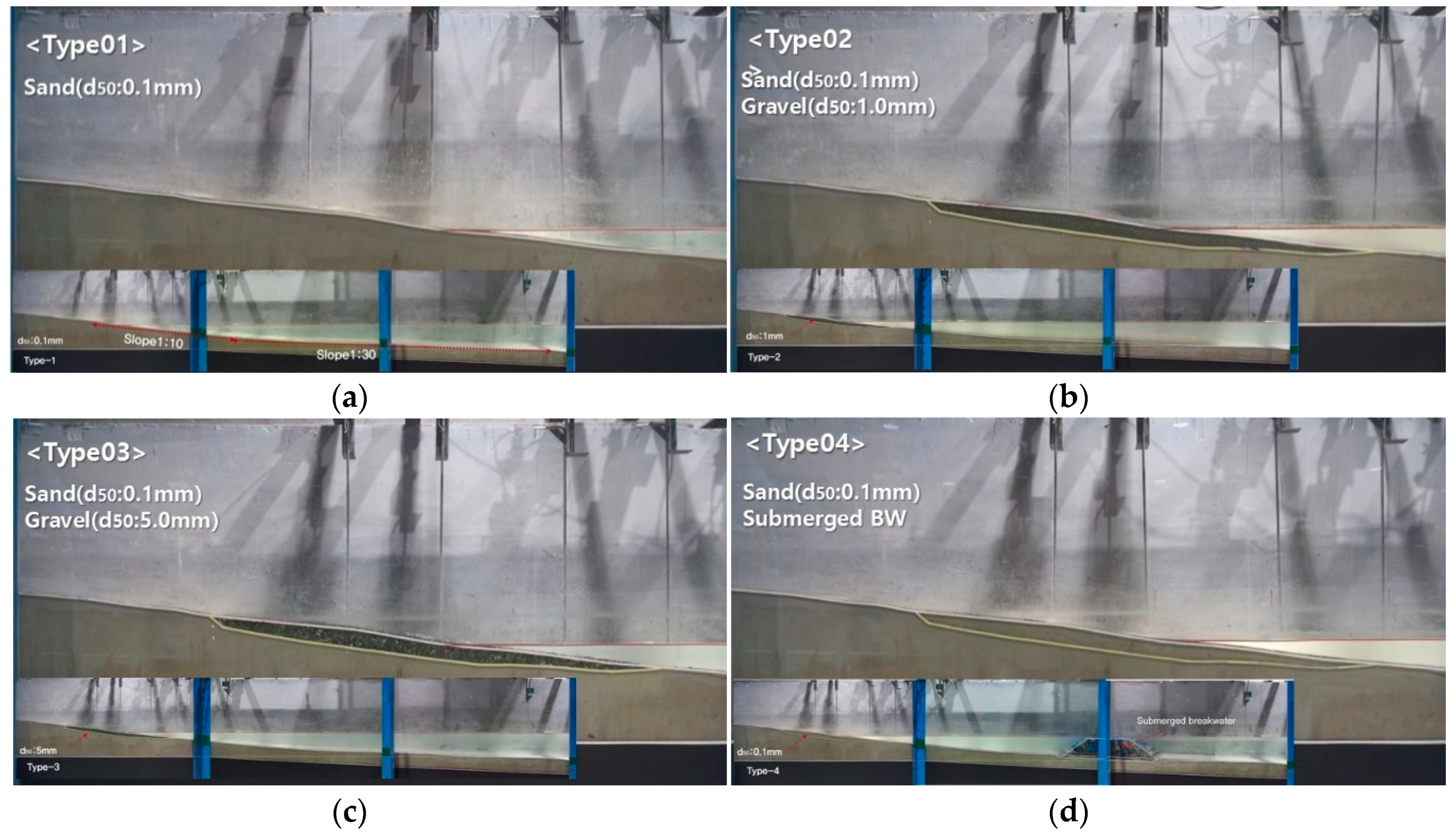
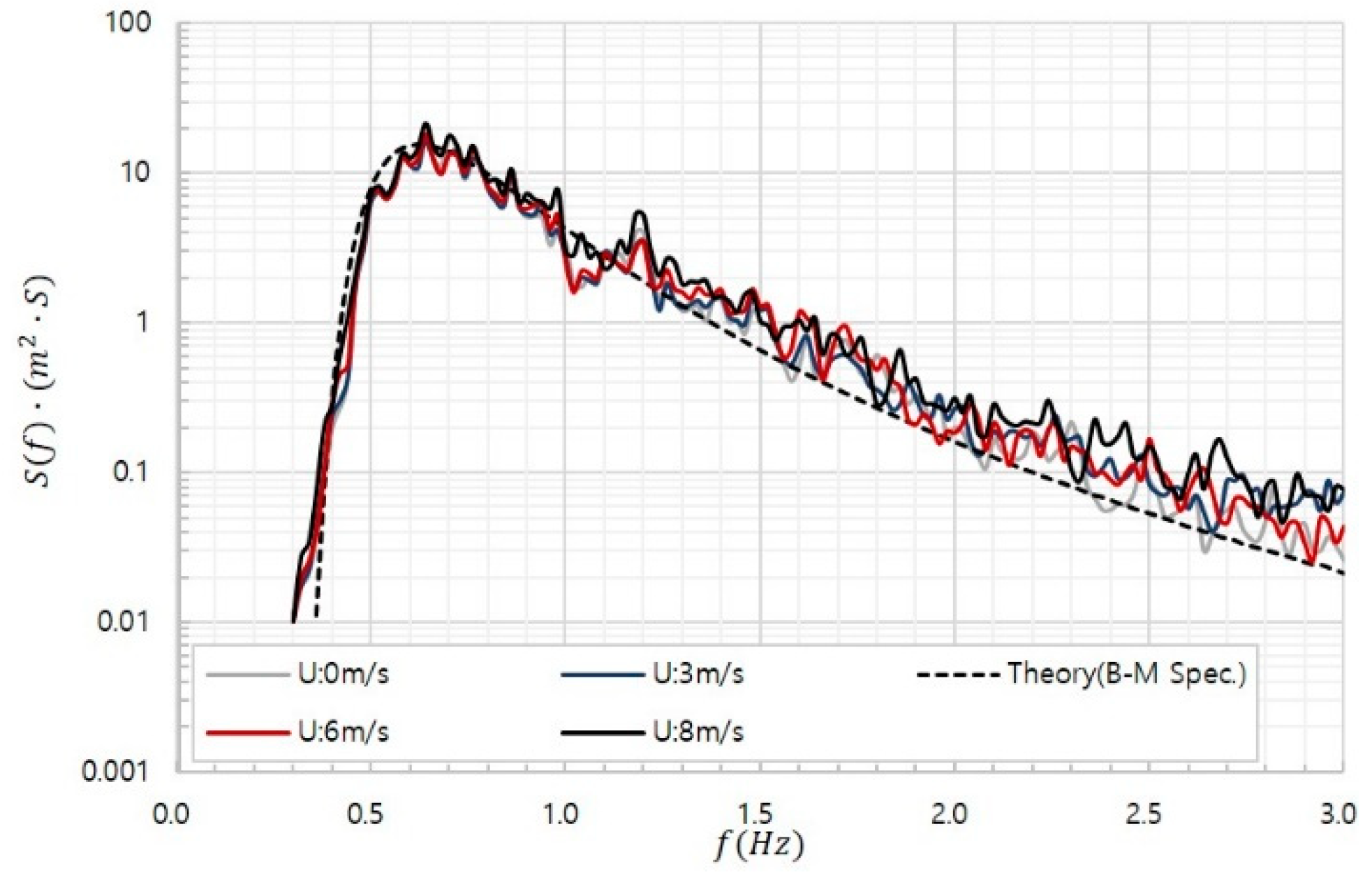
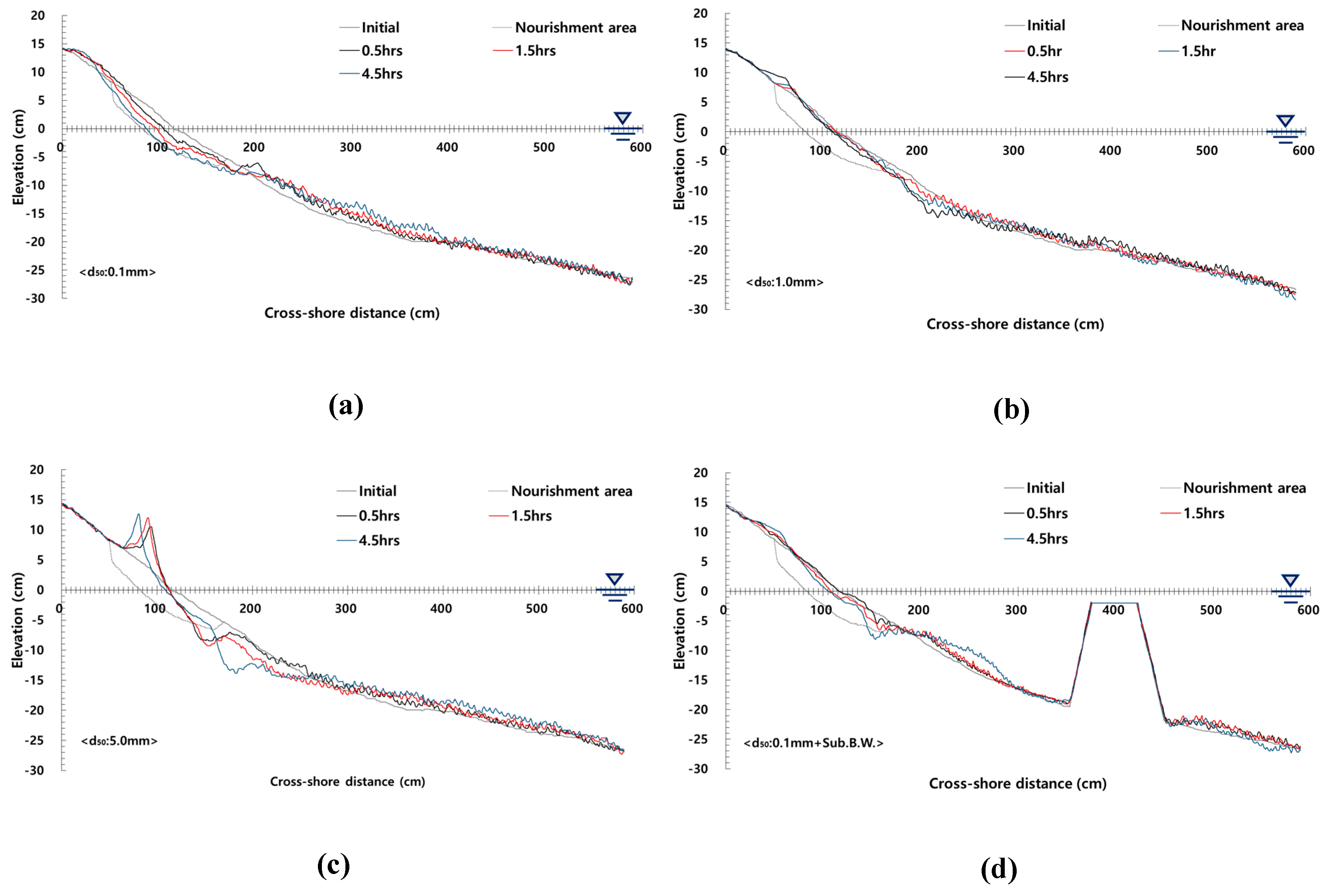
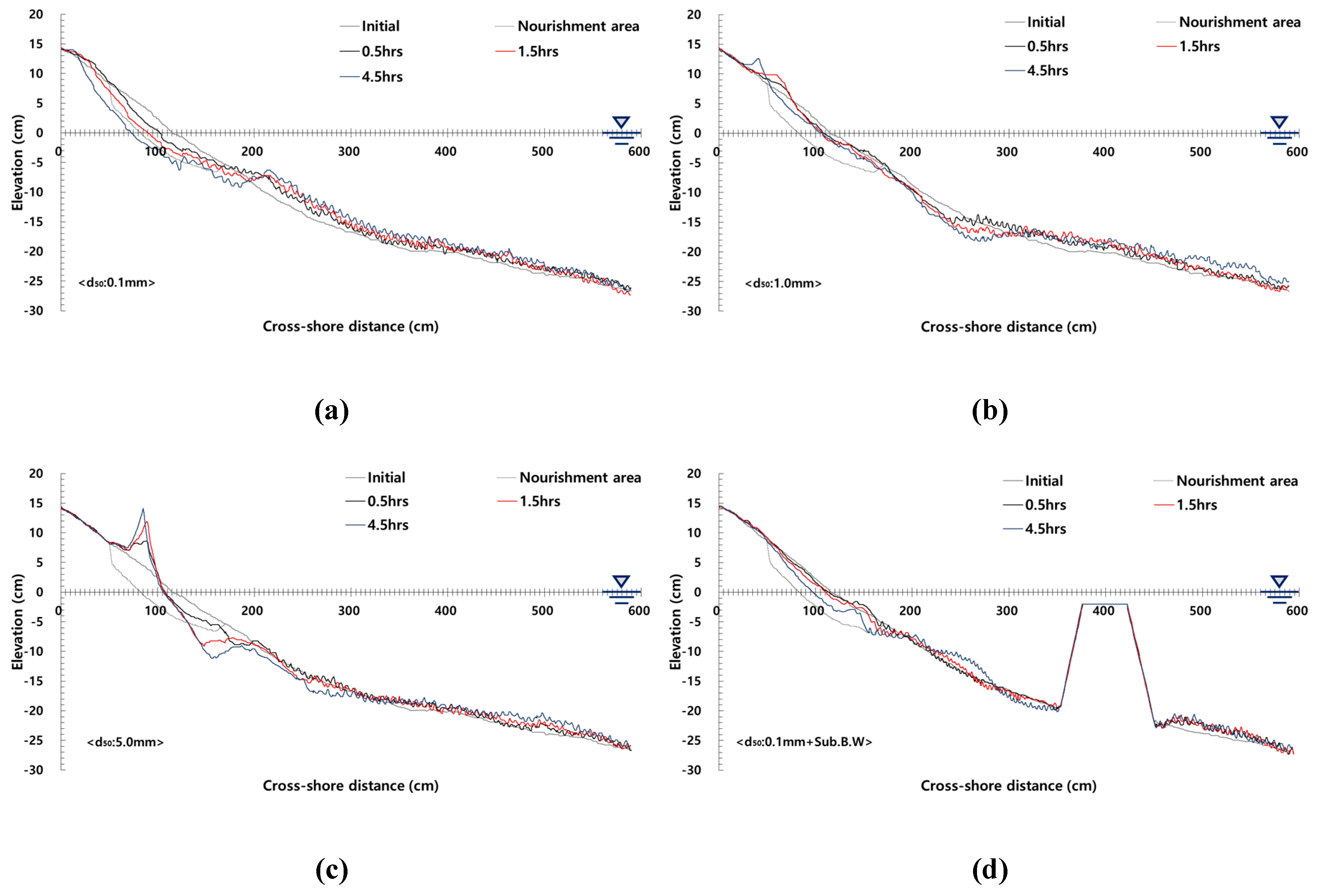
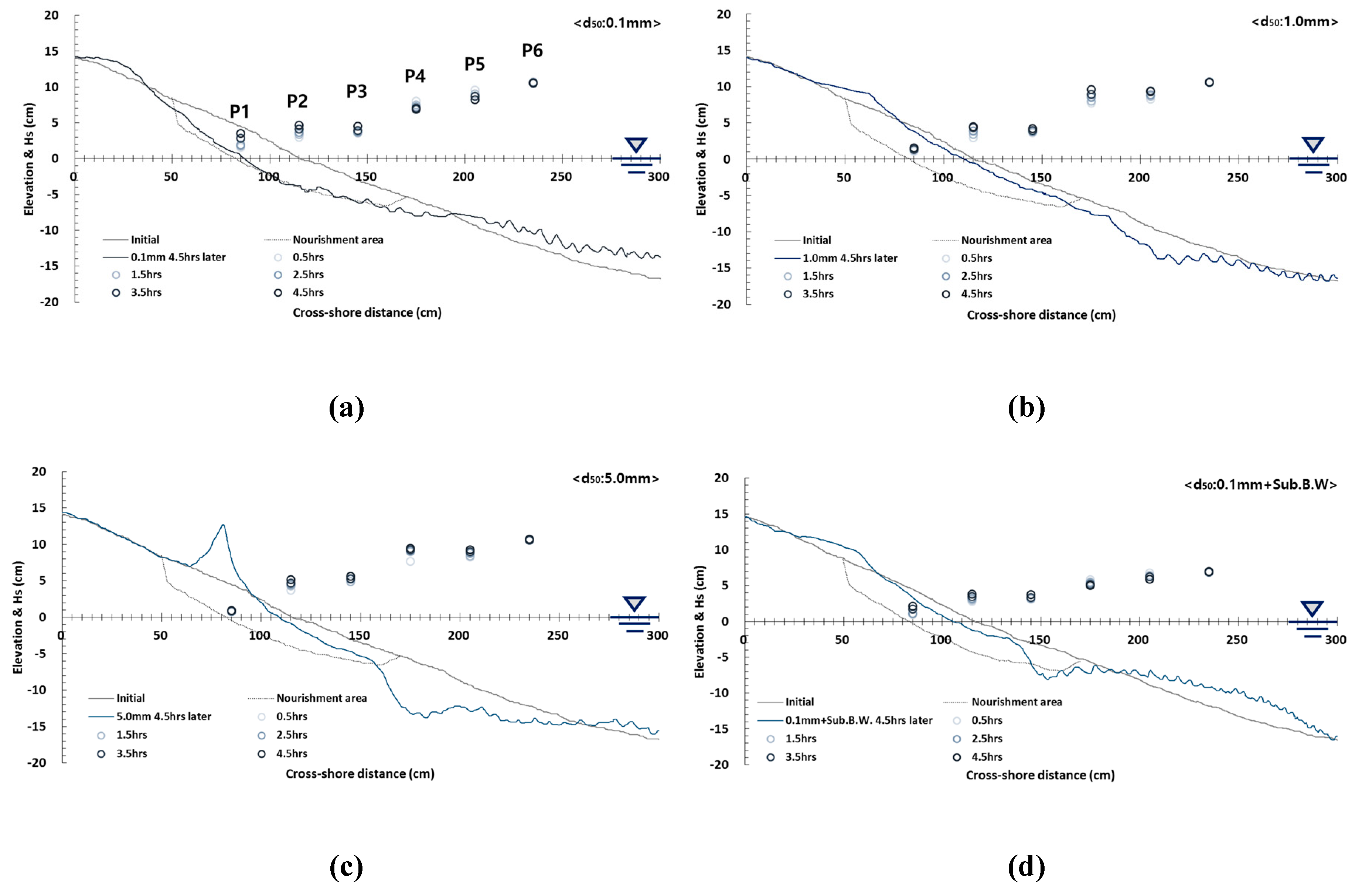
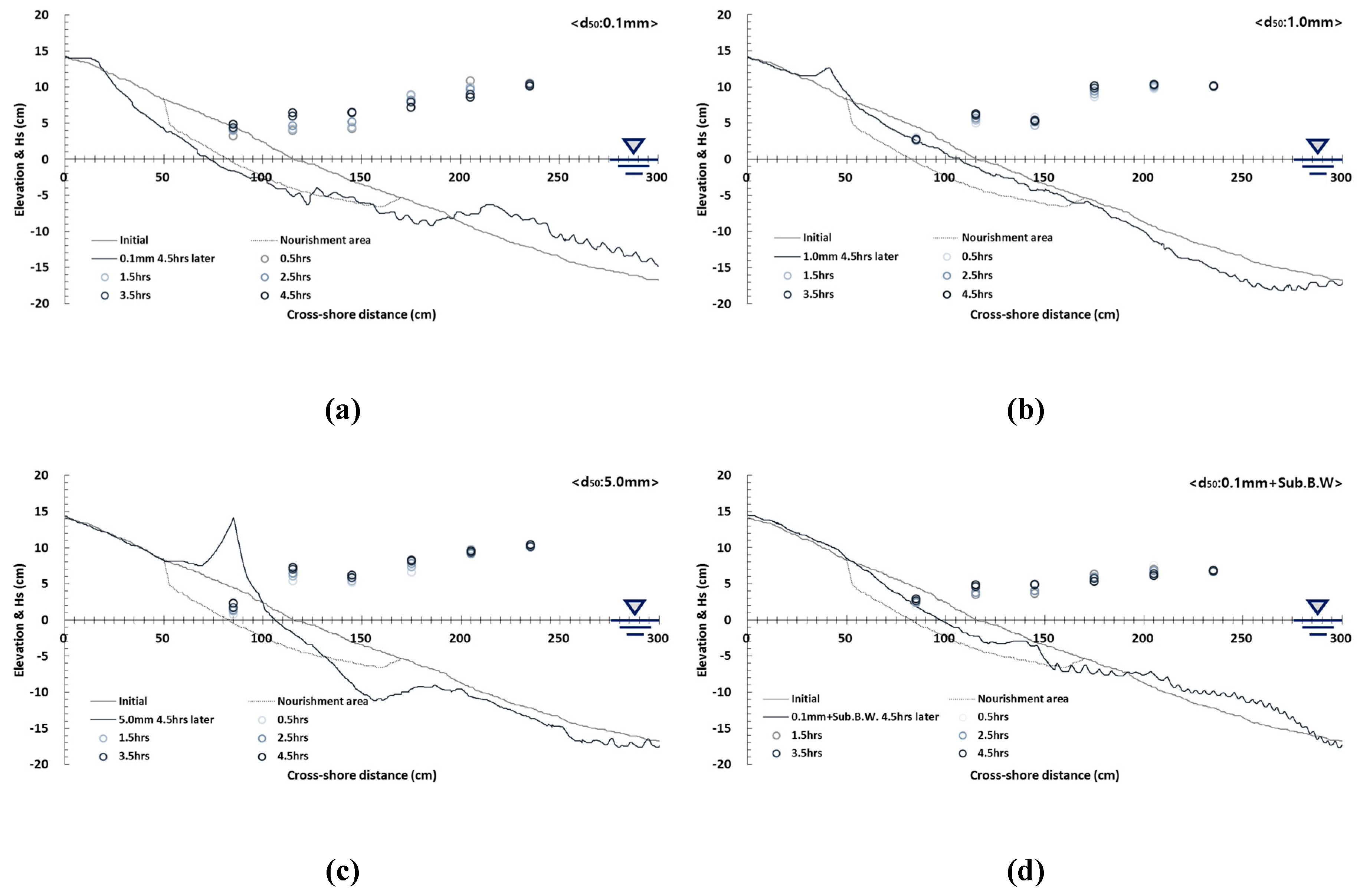
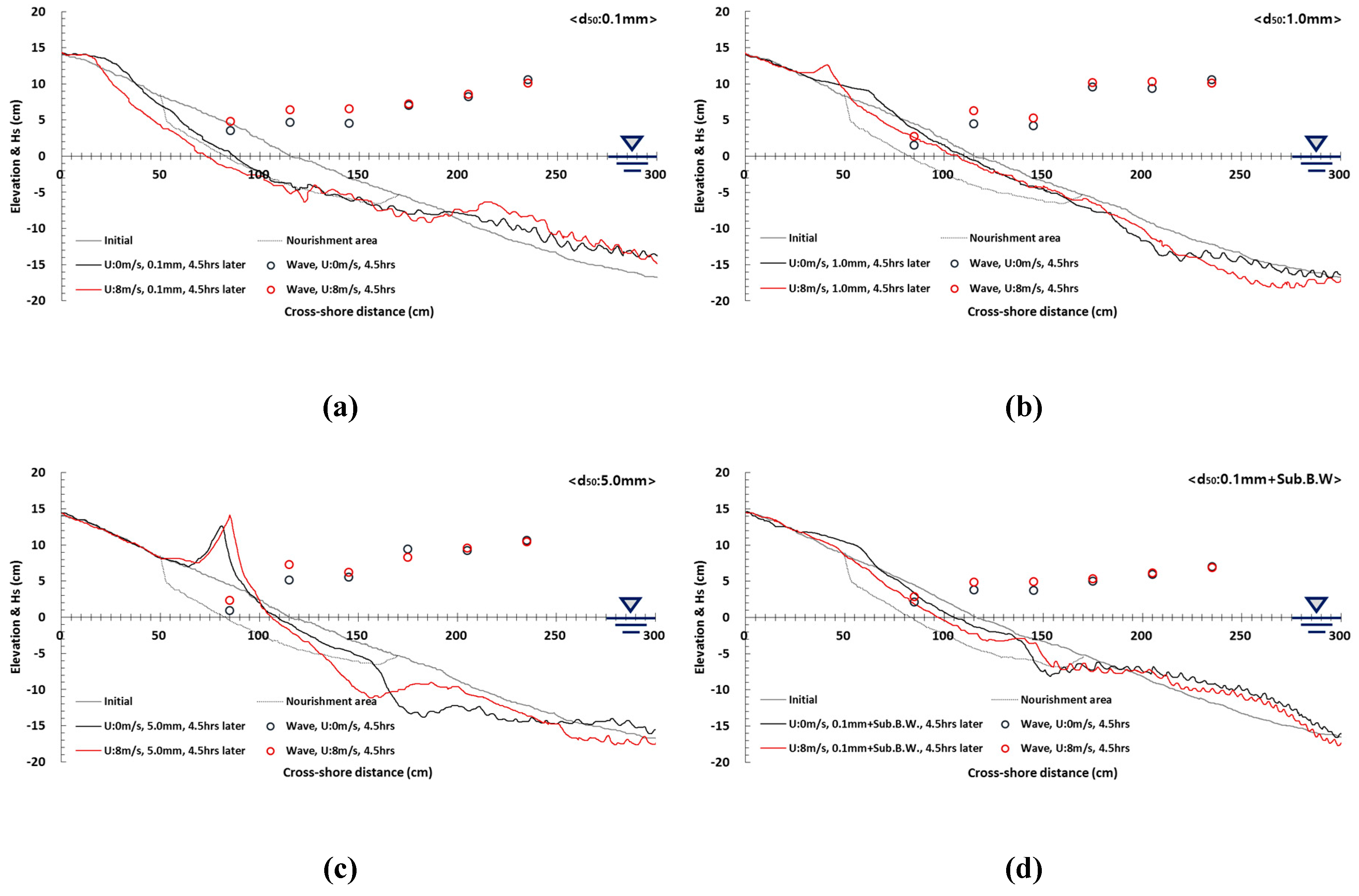

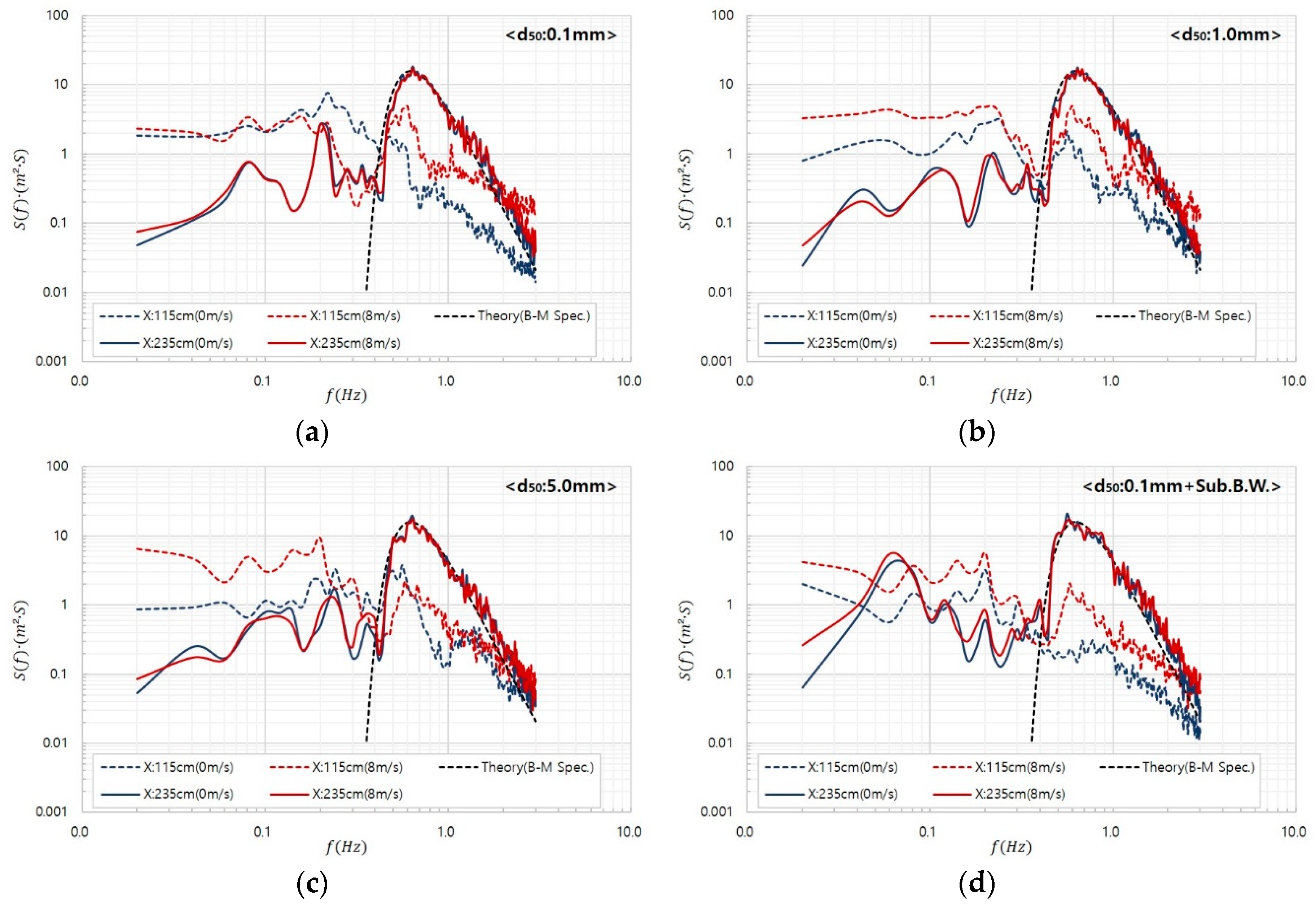

| Case | Water Depth (m) | Hs (m) | Ts (sec) | Wind (m/s) | Nourished Area (d50, mm) | Interval (h) | Slope | C | F0 | Ψ | θ |
|---|---|---|---|---|---|---|---|---|---|---|---|
| Case A | 0.9 | 0.08 | 1.13 | 0 3 6 8 | Type 1: 0.1 Type 2: 1.0 Type 3: 5.0 Type 4: 0.1 | 0.5 ~ 4.5 | 1/10 (foreshore) 1/30 (offshore) | 16.6 3.5, 1.2 | 8.43 072 0.31 | 122.4 12.2 2.5 | 0.48 0.11 0.05 |
| Case B | 0.9 | 0.1 | 1.41 | 17.9 3.8, 1.3 | 8.44 0.72 0.31 | 122.8 12.3 2.5 | 0.45 0.10 0.05 | ||||
| Case C | 0.9 | 0.12 | 1.70 | 19.0 4.1, 1.4 | 8.40 0.72 0.31 | 121.7 12.2 2.4 | 0.42 0.09 0.04 |
© 2019 by the authors. Licensee MDPI, Basel, Switzerland. This article is an open access article distributed under the terms and conditions of the Creative Commons Attribution (CC BY) license (http://creativecommons.org/licenses/by/4.0/).
Share and Cite
Shim, K.-T.; Kim, K.-H.; Park, J.-H. The Effectiveness of Adaptive Beach Protection Methods under Wind Application. J. Mar. Sci. Eng. 2019, 7, 385. https://doi.org/10.3390/jmse7110385
Shim K-T, Kim K-H, Park J-H. The Effectiveness of Adaptive Beach Protection Methods under Wind Application. Journal of Marine Science and Engineering. 2019; 7(11):385. https://doi.org/10.3390/jmse7110385
Chicago/Turabian StyleShim, Kyu-Tae, Kyu-Han Kim, and Jun-Ho Park. 2019. "The Effectiveness of Adaptive Beach Protection Methods under Wind Application" Journal of Marine Science and Engineering 7, no. 11: 385. https://doi.org/10.3390/jmse7110385
APA StyleShim, K.-T., Kim, K.-H., & Park, J.-H. (2019). The Effectiveness of Adaptive Beach Protection Methods under Wind Application. Journal of Marine Science and Engineering, 7(11), 385. https://doi.org/10.3390/jmse7110385






